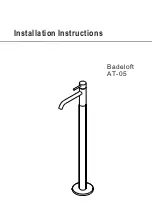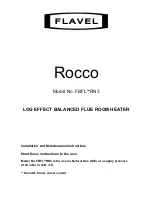
22
www. lochinvar .com
100221773_2000189439_Rev. 01
CLOSED WATER SYSTEMS
Water supply systems may, because of code requirements
or such conditions as high line pressure, among others,
have installed devices such as pressure-reducing valves,
check valves, and back flow preventers. Devices such
as these cause the water system to be a closed system.
RECIRCULATION LOOPS
Combo heating systems and hot water supply recirculation
loop systems require adequate check valves in the loop
piping to prevent passive circulation through the water
heater when the system pump is not operating.
Passive flow, also known as thermo-siphoning, can be
generated when the loop system water is cooler than the
temperature of the water in the heater. This can happen
during long standby periods, during the off heating season
or when the air handler is in air conditioning mode. Passive
flow can cause unwanted firing of the heater resulting in
overheating which can relieve the T&P valve.
THERMAL EXPANSION
As water is heated, it expands (thermal expansion). In a
closed system, the volume of water will increase. As the
volume of water increases, there will be a corresponding
increase in water pressure due to thermal expansion.
Thermal expansion can cause premature tank failure
(leakage). This type of failure is not covered under the
limited warranty. Thermal expansion can also cause
intermittent temperature-pressure relief valve operation:
water discharged from the valve due to excessive pressure
build up. The temperature-pressure relief valve is not
intended for the constant relief of thermal expansion. This
condition is not covered under the limited warranty.
A properly-sized thermal expansion tank should be
installed on all closed systems to control the harmful
effects of thermal expansion. Contact a plumbing service
agency or your retail supplier regarding the installation of
a thermal expansion tank.
Note:
To protect against untimely corrosion of hot and cold
water fittings, it is recommended that di-electric unions or
couplings be installed on this water heater when connected
to copper pipe.
•
Avoid water heater damage.
•
Install thermal expansion tank if necessary.
•
Do not apply heat to the water inlet and outlet connections.
•
Contact qualified installer or service agency.
Property Damage Hazard
CAUTION
METAL
DRAIN
PAN
FLOOR
DRAIN
HOT-WATER
OUTLET
COLD-
WATER
INLET
UNION
UNION
3/4” SWEAT
FITTING
3/4” SWEAT
FITTING
TEMPERATURE-
PRESSURE
RELIEF VALVE
DISCHARGE PIPE
(DO NOT CAP OR
PLUG)
6 in. MAX. AIR
GAP
DRAIN
VALVE
SHUT-OFF VALVE
SOME
COMPONENTS
NOT SHOWN
FOR CLARITY.
Figure 24.
Figure 24 shows typical attachment of water piping to the
water heater. The water heater is equipped with 3/4” NPT
water connections.
Note:
If using copper tubing, solder tubing to an
adapter before attaching the adapter to the water heater
connections. Do not solder the water lines directly to the
water heater connections - it will harm the dip tube and
heat traps and damage the tank.
















































